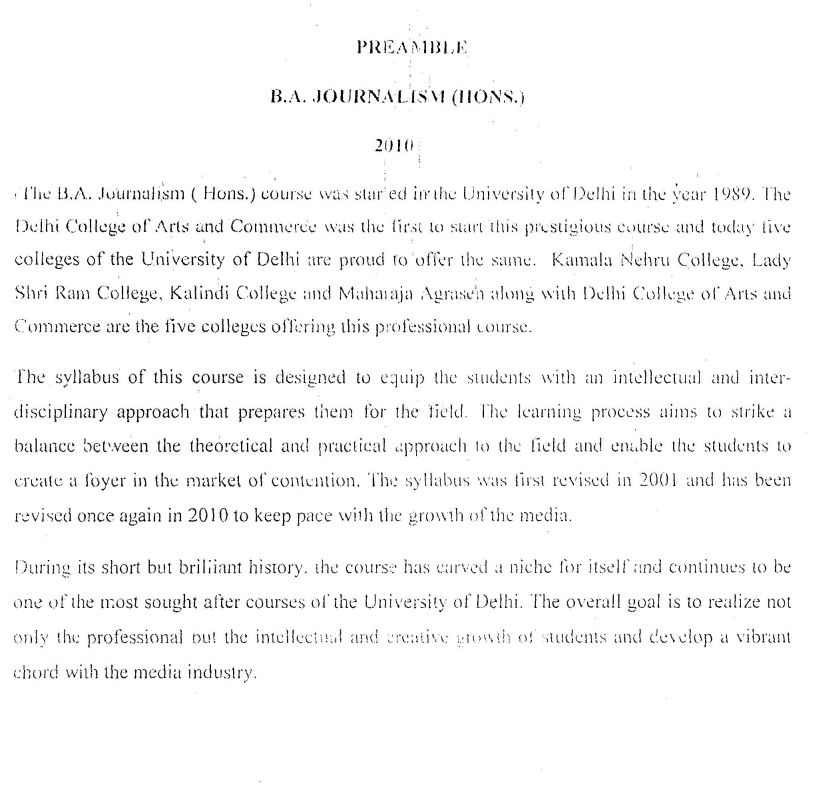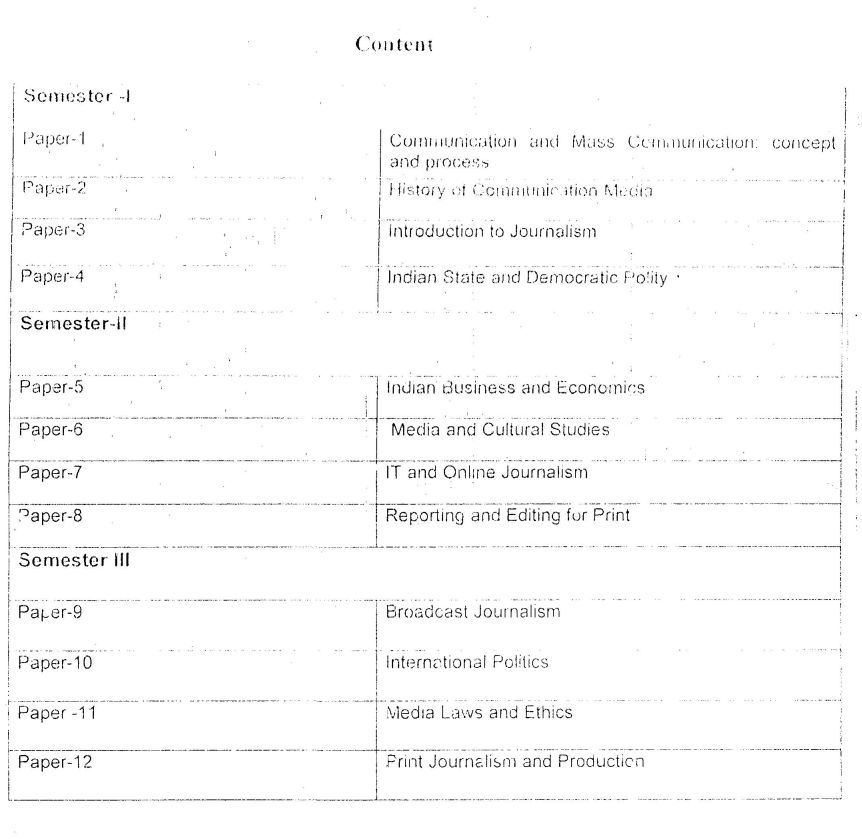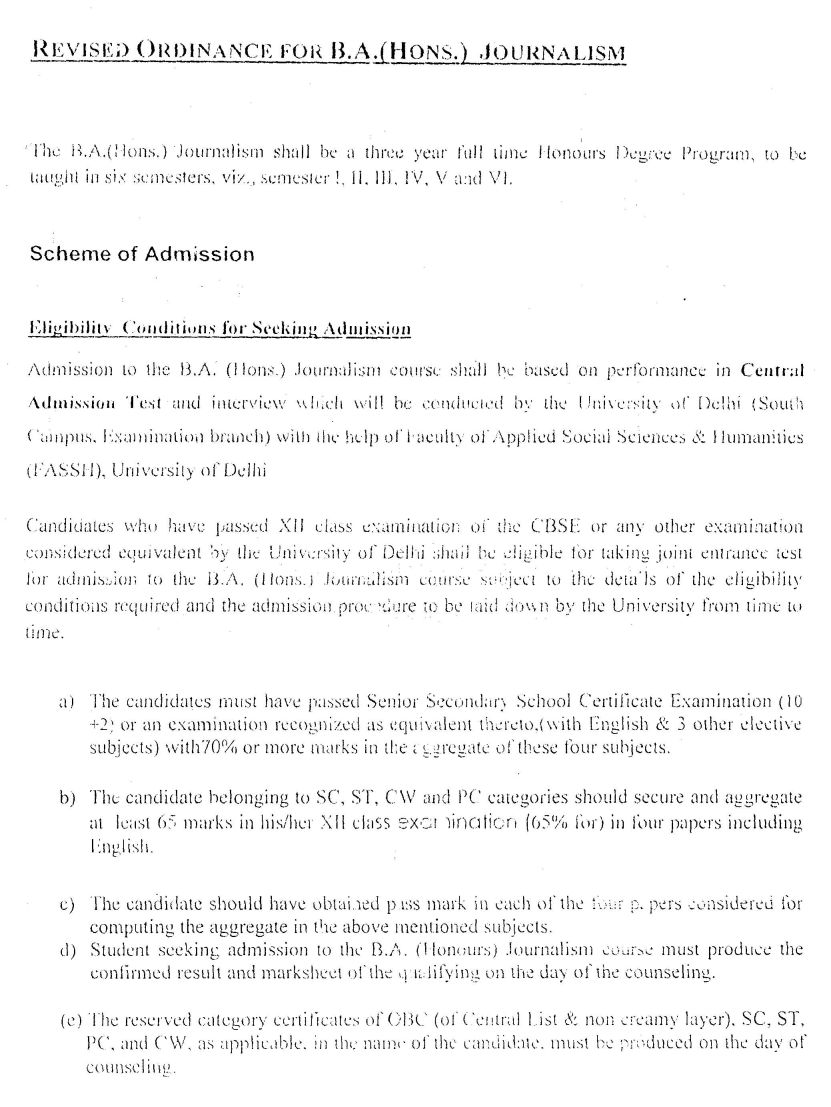|
#2
April 13th, 2015, 11:41 AM
| |||
| |||
| Re: Delhi University Journalism Admission
The University of Delhi is a public central university located in Delhi, India. It was established in 1922. it is approved by UGC. DU B.A. (Hons) Journalism admission Admission to this course shall be based on performance in Central Admission Test and interview Eligibility- XII class examination of the CBSE or any other equivalent examination by the University o f Delhi Candidates must have passed 12th or an examination with English & 3 other elective subjects with70% or more marks in the aggregate At least 65 marks for SC, ST, CW and PC categories in four papers including English Courses structure- Semester-I Paper-I Communication and Mass Communication: Concept and Process. Unit I Introduction to Communication Need for communication; Psychological Perspective; Intrapersonal, Interpersonal, Group and Mass Communication; Different Stages/forms of Communication; Barriers to Communication; Verbal and Non Verbal Communication; Elements of Communication Unit II Models of Communication i)Berlo’s Model; Lasswell’s Five Questions; Osgood and Schramm model, Mathematical Model; Feedback and Processual Nature of Communication; The concept and types of Noise; Effective Communication; Meaning making in communication ii) Gerbner’s model, Newcomb’s model and Westley Maclean’s Gatekeeping Model Unit III Basics of Mass Communication Functions of Mass Communication Theories of Mass Communication i)Mass Society Theory; ii) Direct Effects Paradigm and its theories; Propaganda Unit IV Limited Effects Paradigm i)Personal Influence Theory (Two Step Flow) ii)Individual Difference Theory; Selective Processes iii)Attitude Change iv)Diffusion of Innovation Critique of Effects Tradition and its alternatives Unit V Media and the Public Sphere Cultural Effects Paradigm Agenda Setting Theory; Spiral of Silence; Cultivation Analysis Normative Theories or Theories of the Press (6 theories and their relevance) Paper-II History of Communication Media Unit I Historical Context of the Emergence of Mass Media Technologies Print, Telegraph, Photography, gramophone, cinema, radio, TV, Satellite, Telecommunications, Information Networks Emergence of Mass Media in the Colonial Era with a Focus on India and Its Evolution in the Post colonial Era Unit II Print Media History of the Press in India (Colonial Period; National Freedom Movement, Post Independence Era, Post Emergency Era. Changing Readership, Print Cultures, Language Press Press and the Indian State Changing Pattern of Newspaper Economy Recent Developments in Print Media Unit III Sound Media From Oral Music to Gramophone Early history of Radio in India History of AIR: Evolution of AIR Programming Radio in the Context of the State’s Development Agenda Patterns of State Control; the Demand for Autonomy Formation of Prasar Bharati FM: Radio Privatization Music: Cassettes to the Internet Unit IV Visual Media The early years of Photography, Lithography and Cinema From Silent Era to the talkies Cinema in later decades The coming of Television and the State’s Development Agenda Commercialization of Programming (1980s) Invasion from the Skies: The Coming of Transnational Television (1990s) Changing Broadcasting Policies and Regulations Formation of Prasar Bharati Unit V The History of telecommunication and Informatics New Media Technologies; Digital Media Overview of the Contemporary Mediascape DU B.A. (Hons) Journalism admission      Contact details University of Delhi New Delhi, Delhi 110021 011 2700 6900 Map location For more details here is the attachment...................... |